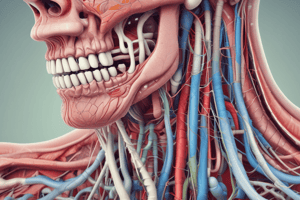Podcast
Questions and Answers
What is the primary function of CamScanner?
What is the primary function of CamScanner?
- To create presentations
- To scan documents (correct)
- To edit photos
- To send emails
Which file formats can CamScanner typically create?
Which file formats can CamScanner typically create?
- DOC and XLS
- HTML and TXT
- PDF and DOCX (correct)
- JPEG and PNG
What feature is NOT commonly associated with CamScanner?
What feature is NOT commonly associated with CamScanner?
- Optical character recognition (OCR)
- Social media networking (correct)
- Document storage
- Image editing
Which of the following describes an advantage of using CamScanner?
Which of the following describes an advantage of using CamScanner?
What can users do with the scanned documents in CamScanner?
What can users do with the scanned documents in CamScanner?
Flashcards
CamScanner app
CamScanner app
A mobile application for scanning documents.
Document scanning
Document scanning
The process of converting physical documents into digital images.
Mobile application
Mobile application
Software designed to run on a smartphone or tablet.
Digital images
Digital images
Signup and view all the flashcards
File format
File format
Signup and view all the flashcards
Study Notes
Accessory Organs of the Gastrointestinal System
- Accessory organs aid the digestive process, but aren't part of the main pathway
- Salivary glands, liver, gallbladder, and pancreas are examples
- Teeth and tongue are instrumental in chewing and initial digestion.
Salivary Glands: Definition & Classification
- Major salivary glands: Parotid, submandibular, and sublingual
-
Secrete saliva continuously, via ducts
-
Parotid: serous, located near the ear, largest
-
Submandibular: seromucous, located below the jaw
-
Sublingual: mucous, located under the tongue
-
- Minor salivary glands: numerous, located in oral mucosa.
- Secrete continuously, in various locations
Salivary Gland: Major and Minor
- Major: Parotid (serous, large), Submandibular (seromucous, substantial size), and Sublingual (mucous, under tongue).
- Minor: Lingual, buccal (cheek), palatine (roof of mouth), numerous, in the mucosal linings.
Neurovasculature of the Salivary Glands
- Saliva production varies by gland type and stimulus.
- Blood supply differs based on the salivary gland type.
- Venous drainage varies, based on gland location
- Innervation (nerve supply) varies based on gland type.
- Lymphatic drainage goes to specific lymph nodes, depending on gland position.
Pancreas
- Elongated, about 15 cm, located behind the stomach.
- Primarily retroperitoneal (except tail)
- Parts: head, body, tail, and uncinate process.
- Important role in digestion, producing enzymes and hormones.
Pancreas: Must-know structures
- Duct of Wirsung (main pancreatic duct)
- Main pancreatic duct
- Ampulla of Vater
- Sphincter of Oddi
- Minor Duodenal Papilla
Parts of the Pancreas
- Head: widest part, anterior to superior mesenteric vessels
- Uncinate process: inferior projection from head, behind superior mesenteric vessels
- Tail: intraperitoneal, near the spleen
- Other parts: body and neck
Pancreas: Neurovasculature
- Blood supply from splenic, pancreaticoduodenal, gastroduodenal, and superior mesenteric arteries
- Venous drainage varies, based on area.
- Nerve supply: parasympathetic (vagus) and sympathetic nerves
- Lymphatic drainage goes to various nodes depending on the location.
Gallbladder
- Pear-shaped sac, located on the inferior surface of the liver, mostly intraperitoneal.
- Structure: fundus (top), body, neck
- Parts: cystic duct, common bile duct
- Stores and concentrates bile, secreted by the liver.
Gallbladder: Structure
- Parts: fundus, body, and neck
- Cystic duct leads to the common bile duct
- Gallbladder stores and concentrates bile.
Gallbladder: Relations
- Anatomical locations of the gallbladder related to organs such as liver, common bile duct, cystic duct.
- Detailed relationships of the gallbladder to organs.
Blood Supply, Innervation and Lymphatics of Gallbladder
- Blood supply: cystic artery, which is a branch from the right hepatic artery.
- Innervation: vagus nerve and branches of celiac plexus
- Lymphatic drainage: cystic nodes
Liver: Location and Regions
- Location related to rib cage.
- Location relative to other organs within the abdomen
- Key anatomical areas on surface and interior of the liver
Liver: Surfaces, Ligaments and Recesses
- Visceral surface: mostly covered in visceral peritoneum, except the bare area.
- Ligaments: falciform, coronary, round, triangular, are all key anatomical areas.
- Recesses: important to consider when imaging, for locating fluid.
Liver: Lobes, Segments and Porta Hepatis
- Lobes: right, left, caudate and quadrate lobes, specific regions within the liver.
- Segments: division based on vascular and biliary branches, not on lobes.
- Porta hepatis: key anatomical structure at the portal where essential blood vessels and ducts pass to the liver.
Liver: Impressions
- Impressions show where the liver is located near other organs
- Detailed description of the anatomical surfaces of the liver impacted by neighbor organs.
Liver: Blood Supply and Venous Drainage
- Hepatic artery and portal vein are primary sources.
- Blood vessels and drainages for the liver.
Liver: Lymphatics and Innervation
- Lymphatic drainage: hepatic nodes
- Nerve supply: autonomic (sympathetic and parasympathetic).
Studying That Suits You
Use AI to generate personalized quizzes and flashcards to suit your learning preferences.




